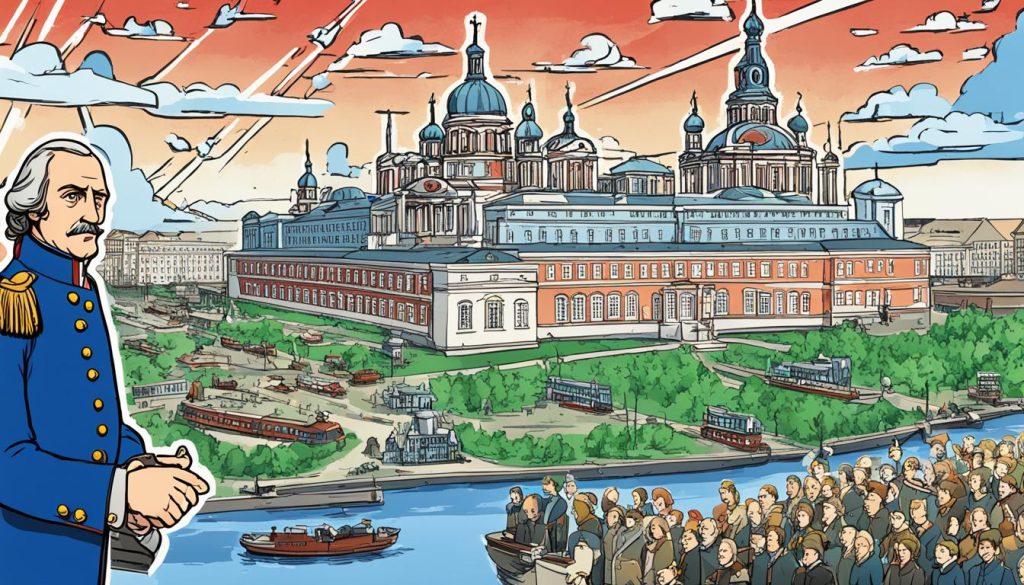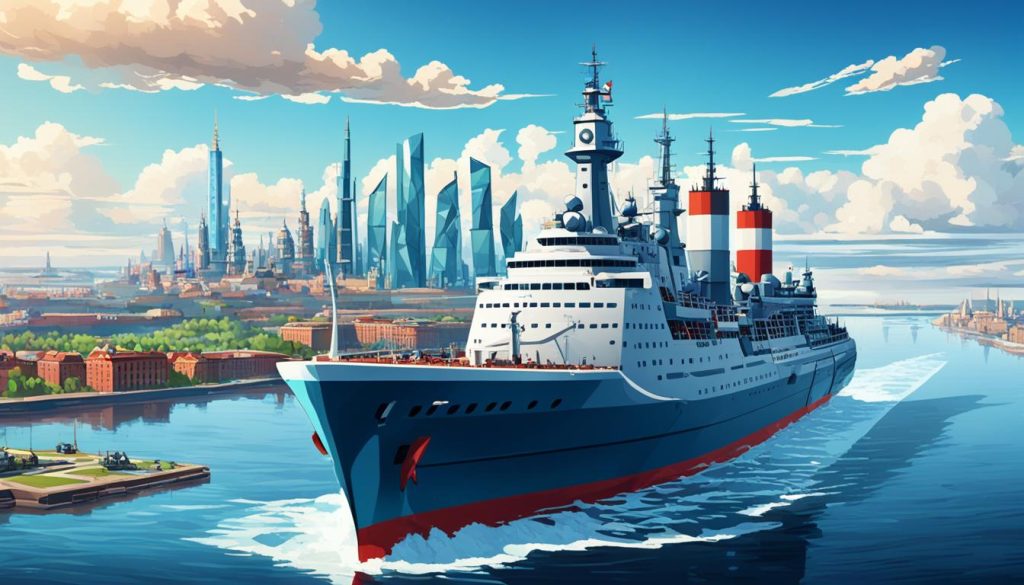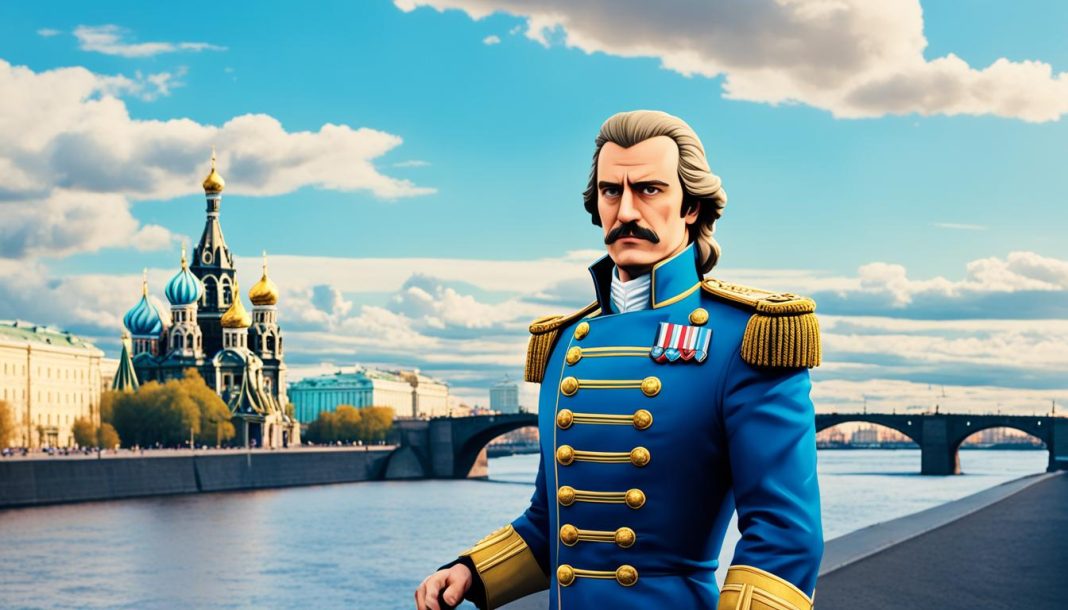
Once upon a time in the vast lands of Russia, there lived a leader whose vision would shape the destiny of an empire. This leader was known as Peter the Great, or Tsar Peter I, of the Romanov dynasty. His reign marked a pivotal moment in Russian history, as he ushered in a new era of progress and transformation that would forever leave its mark on the nation.
It was a time when Russia was a vast and sprawling land, still deeply rooted in its traditional ways. But Peter had a different vision for his country. He wanted Russia to become a modern European power, ready to take its place on the global stage. And so, he set out on a journey of reform and achievement that would change the course of history.
As he embarked on his ambitious goals, Peter faced numerous challenges and adversaries. One of his greatest achievements was leading Russia to victory in the Great Northern War, a conflict that secured Russia’s position as a major player on the geopolitical map. Through his strategic leadership and military prowess, Peter expanded the Russian Empire, acquiring new territories and establishing dominance in the region.
But Peter’s ambitions were not confined to military conquest alone. He had a grand vision for the future of Russia, one that extended beyond the battlefield. Peter the Great founded the city of St. Petersburg, a symbol of his aspiration to create a more modern and European Russia. The city flourished under his guidance, becoming a vibrant cultural and economic hub that showcased the progress and achievements of the Russian Empire.
Key Takeaways:
- Peter the Great was a visionary leader who transformed Russia during the 17th and 18th centuries.
- He led Russia to victory in the Great Northern War, expanding the Russian Empire and securing its position as a major power.
- Peter the Great founded the city of St. Petersburg, a testament to his vision of a more modern and European Russia.
- His reforms and achievements had a lasting impact on Russian history, shaping the course of the nation.
- Peter the Great’s leadership and strategic thinking played a crucial role in Russia’s transformation and rise to prominence.
Early Life and Ascension to the Throne
Peter the Great, born on June 9, 1672, in Moscow, Russia, played a pivotal role in Russian history as a member of the Romanov dynasty. In 1682, he assumed the position of tsar, sharing power with his half-brother, Ivan V. However, Peter quickly emerged as the dominant force, ushering in a new era of modernization for Russia.
Driven by a visionary mindset, Peter initiated a series of reforms and changes to propel Russia forward. His ambition to transform the nation prompted him to officially take sole control of the throne in 1696, marking the beginning of his transformative reign.
With a relentless determination, Peter the Great embarked on a mission to modernize Russia on various fronts. From military reforms to social and political changes, he sought to propel Russia onto the global stage as a formidable power.
“I shall work to drag my Russia out of the medieval mire, to raise her to the level of contemporary states.”
His ascendancy to the throne marked the beginning of a remarkable chapter in Russian history, wherein Peter the Great would leave an indelible mark that continues to resonate today.
Military Reform and Expansion
One of Peter the Great’s major accomplishments was the reform and expansion of the Russian military. He recognized the need for modernization in order to defend and expand the Russian Empire. To achieve this, Peter introduced rigorous training programs, modernized equipment, and implemented a new ranking system based on merit.
The reform of the Russian military under Peter the Great was a significant undertaking. He established schools and academies to provide comprehensive training to soldiers, emphasizing discipline and tactical skills. This emphasis on training and discipline transformed the Russian army into a formidable force.
Peter’s modernization efforts also extended to equipment. He invested heavily in the production and acquisition of advanced weaponry, including artillery and firearms. This shift from outdated weapons to more efficient and reliable arms significantly enhanced the military capabilities of the Russian Empire.
Additionally, Peter the Great introduced a new ranking system that rewarded individuals based on merit rather than social status. This system ensured that the most qualified and capable individuals held positions of authority within the military. Through this reform, Peter increased the professionalism and effectiveness of the armed forces.
These changes in military organization and training played a crucial role in Russia’s success in the Great Northern War. The Russian army, under Peter’s leadership, achieved significant victories against Sweden, establishing Russia as a major power in Northern Europe and expanding its territorial holdings.
Overall, Peter the Great’s military reform and expansion efforts were instrumental in strengthening the Russian Empire. His commitment to modernization paved the way for future military successes and secured Russia’s position as a major player in European affairs.
Building of St. Petersburg
Another remarkable achievement of Peter the Great was the founding of the city of St. Petersburg, which played a pivotal role in shaping Russian history and the Russian Empire. Established in 1703, St. Petersburg was strategically positioned as a port on the Baltic Sea, allowing Russia to expand its trade and establish connections with the rest of Europe.
Peter the Great personally oversaw the construction of magnificent buildings, canals, and bridges, transforming the marshy area into an architectural marvel and a flourishing cultural and economic center. The grandeur of St. Petersburg reflected Peter’s vision of a more modern and European Russia. Its stunning architecture, influenced by Western European styles, showcased Russia’s emergence as a powerful empire on the global stage.
With St. Petersburg as the new capital, Peter the Great’s aspirations for Russia to become a European power became tangible. The city became a center for art, literature, and education, attracting intellectuals and artists from around the world. The illustrious Hermitage Museum, originally a palace built for Empress Elizabeth, houses one of the world’s most extensive collections of art and cultural artifacts.
The image below captures the impressive architecture and the rich history of St. Petersburg:
St. Petersburg stands as a testament to Peter the Great’s legacy, showcasing his visionary leadership and his ambition to create a more progressive and cosmopolitan Russia. It continues to be a symbol of Peter’s influence on the Russian Empire and remains one of the most iconic cities in the world.
Domestic and Political Reforms
Peter the Great’s reign as Tsar of Russia witnessed various significant domestic and political reforms that reshaped the Russian Empire and solidified the authority of the monarchy. Through his progressive agenda, Peter aimed to centralize power, increase efficiency, and modernize the government, thereby strengthening Russia’s position on the world stage.
One of the key aspects of Peter the Great’s domestic reforms was his effort to reduce the influence of the nobility. By centralizing power and curtailing the privileges of the nobles, Peter aimed to consolidate authority under the monarchy, fostering a more unified and cohesive Russian Empire.
To achieve this, Peter introduced new administrative structures and institutions that aimed to streamline the bureaucracy and improve governance. These reforms included the establishment of administrative bodies such as the Senate and the Collegiums, which served as specialized departments responsible for various aspects of governance.
Furthermore, Peter implemented reforms to modernize the legal system and enhance the rule of law in Russia. He issued the “Table of Ranks,” a hierarchical system that defined social status and career advancement based on merit rather than birthright. This system aimed to promote loyalty to the monarchy and incentivize competence and meritocracy within the government.
Peter the Great’s domestic reforms also extended to education and culture. Recognizing the importance of knowledge and modernization, he established the first Russian universities, including the Academy of Sciences, which greatly contributed to the advancement of scientific research and intellectual pursuits.
“Peter the Great’s reforms aimed to centralize control, streamline bureaucracy, and create a more efficient and responsive government, paving the way for the Russian Empire’s transformation.”
These domestic reforms implemented by Peter the Great during his reign had a profound and lasting impact on the Russian Empire. By modernizing the government, consolidating power, and promoting meritocracy, Peter laid the foundation for the future development of Russia as a formidable European power.
Foreign Policy and Expansion
Peter the Great, a visionary leader, pursued an ambitious foreign policy to expand Russia’s territory and influence. One of his notable endeavors was the Great Northern War, a conflict aimed at securing vital trade routes and establishing Russia as a major European power.
This war allowed Peter to showcase his military prowess and strategic acumen, leading to significant territorial gains for the Russian Empire. Through his military successes, including the acquisition of Estonia, Latvia, and parts of Finland, Peter elevated Russia’s status on the world stage and solidified its position as a dominant force in the region.
With an unwavering focus on expansion, Peter the Great laid the foundation for Russia’s future as a global power, leaving a lasting impact on Russian history and shaping the course of the Russian Empire.
Legacy and Impact
Peter the Great’s reign brought about a significant legacy and had a profound impact on Russia and the world. His relentless pursuit of reforms and modernization transformed Russia into a major European power, forever altering its history.
The city of St. Petersburg stands as a testament to Peter the Great’s visionary leadership. His ambitious vision and determination led to the establishment of this vibrant cultural and economic center, which became the new capital of Russia. The majestic buildings, canals, and bridges constructed under his guidance highlight his commitment to creating a more modern and European Russia.
“The city of St. Petersburg, founded by Peter the Great, showcases his desire to create a new Russia that rivaled the grandeur of Western Europe.”
However, Peter the Great’s impact extends well beyond architectural achievements. His military strategies and victories in the Great Northern War solidified Russia’s position as a major player in international affairs. By acquiring territories such as Estonia, Latvia, and parts of Finland, he expanded the Russian Empire’s boundaries and influence.
Peter the Great’s reign marked a turning point in Russian history, setting the stage for future developments in the Russian Empire. His reforms modernized the government, centralized power, and streamlined the bureaucracy, making the Russian Empire more effective and responsive.

Overall, Peter the Great’s legacy is a testament to his visionary leadership and strategic thinking. His reforms, military successes, and transformation of St. Petersburg continue to shape Russian history and inspire further study and analysis of his contributions.
Evaluation of Peter the Great’s Leadership
Peter the Great’s leadership can be assessed through the lens of strategic leadership, highlighting his significant contributions to Russian history. He exemplified strategic thinking skills, such as holistic thinking and conceptual thinking, which enabled him to envision and execute transformative reforms.
As a strategic leader, Peter the Great demonstrated exceptional competencies in coordinating ends, ways, and means across various domains. His military reforms, political strategies, and domestic initiatives were all guided by a strong sense of purpose and a far-reaching vision for Russia’s development.
“I am not an ordinary king; I am a constructor of a new Russia.”
Peter the Great’s strategic approach to leadership was particularly evident in his military reforms. By modernizing the Russian military through rigorous training programs, updated equipment, and a merit-based ranking system, he transformed it into a disciplined and efficient force. This strategic strengthening of Russia’s military capabilities played a pivotal role in their success during the Great Northern War and the subsequent expansion of the Russian Empire.
Additionally, Peter the Great’s strategic leadership extended to domestic and political reforms. His efforts to centralize power and streamline the bureaucracy aimed to create a more effective and responsive government. By reducing the influence of the nobility and strengthening the authority of the monarchy, he fostered a more cohesive and unified Russia.
“Reforms, reforms, and always more reforms.”
Furthermore, Peter the Great’s visionary approach to leadership can be seen in his foreign policy and expansion efforts. By engaging in wars and acquiring new territories, such as Estonia, Latvia, and parts of Finland, he strategically positioned Russia as a major player on the international stage.
This exceptional strategic leadership, coupled with Peter the Great’s drive for progress and innovation, paved the way for Russia’s transformation into a modern European power.
The Legacy of Strategic Leadership
Through his strategic leadership, Peter the Great left an indelible mark on Russian history. His vision and reforms laid the foundation for future developments in the Russian Empire.
Moreover, his creation of St. Petersburg, a city that symbolized Russia’s connection to Europe and served as a testament to his vision, remains a lasting legacy of his strategic thinking.
“I want Russia to be as advanced as other European countries.”
Peter the Great’s strategic leadership not only shaped Russia’s trajectory but also positioned it as a global power. His ability to envision and execute transformative reforms continued to influence Russian leaders and thinkers for generations to come.
Conclusion
Peter the Great’s reign as Tsar of Russia had a profound impact on the nation and its history. Through military reform, expansion, the building of St. Petersburg, domestic and political reforms, and ambitious foreign policy, he transformed Russia into a modern European power. His strategic leadership and visionary approach paved the way for future developments, shaping Russian history significantly.
Under Peter’s rule, Russia underwent a period of remarkable change, marked by reforms and modernization. His military strategies and victories in the Great Northern War solidified Russia’s position as a major player on the global stage. Meanwhile, the foundation of St. Petersburg as a cultural and economic center reflected his vision of a more modern and European Russia.
Peter the Great’s legacy continues to be studied and evaluated for his significant contributions to Russia’s transformation. His leadership skills, including coordination of ends, ways, and means, demonstrated his ability to envision and implement transformative reforms. Peter’s strategic thinking skills, such as holistic and conceptual thinking, enabled him to shape the course of Russian history and secure Russia’s place as a prominent player in international affairs.
Thanks For Reading…Peter the Great: Russia’s Visionary Leader
How much did you like Peter the Great: Russia’s Visionary Leader? Please share your views in the comment box. Also, please share this story with your friends on social media so they can enjoy it, and for more such stories, please bookmark storiespub.com.
Check out other stories that we have:
























